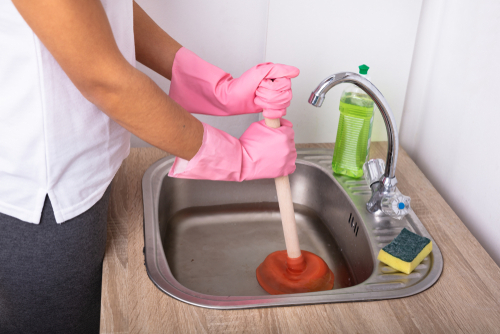Master Plungers and Drain Cleaner: Effective Techniques
Master Plungers and Drain Cleaner: Effective Techniques
Blog Article
In this article in the next paragraphs yow will discover a lot of first-rate help and advice involving How To Use Your Toilet Plunger Correctly in 5 Easy Steps.

Introduction
Appropriate upkeep of family drains pipes is necessary for protecting against obstructions and ensuring smooth water circulation. One of the key tools in every house owner's toolkit is the bettor, alongside numerous drainpipe cleaners developed to tackle persistent blockages effectively. This write-up discovers how to make use of plungers and drainpipe cleansers efficiently to keep your drains streaming freely.
Section 1: Recognizing Plungers
Types of Plungers
There are numerous kinds of bettors available, each made for different sorts of drains and blocks. One of the most usual types consist of mug plungers, flange bettors, and accordion plungers.
How Plungers Job
Bettors service the principle of producing stress and suction to dislodge clogs. When appropriately used over a drainpipe, they produce a vacuum that can pull out debris or break up blockages.
Choosing the Right Bettor
Picking the ideal plunger depends on the type of drainpipe and the nature of the obstruction. Cup plungers are perfect for sinks and tubs, while flange bettors are better suited for commodes due to their layout.
Usual Errors with Bettors
Avoiding these errors makes certain reliable plunging: inappropriate seal around the drainpipe, inadequate pressure, and not clearing bordering debris.
Area 2: Using Plungers Successfully
Prep work
Before diving, ensure the plunger covers the drainpipe completely and creates a tight seal. Clear any type of visible particles around the drainpipe opening.
Strategy
Start with gentle diving movements to build suction. Increase pressure progressively, using a stable rhythm. Repeat as needed up until the drainpipe removes.
Fixing Tips
If diving doesn't work, try adjusting the seal, applying oil jelly for a far better seal, or making use of a various kind of plunger.
Section 3: Understanding Drainpipe Cleansers
Kinds Of Drain Cleaning Company
Drain pipes cleaners can be chemical or chemical. Chemical cleaners utilize strong chemicals to dissolve obstructions, while chemical cleansers use natural enzymes to break down raw material.
Just How Drain Cleaners Job
Chemical cleansers react with obstructions to dissolve them, while chemical cleansers break down organic materials like hair and oil without harming pipelines.
Safety and security Considerations
Constantly wear gloves and eye defense when utilizing chemical drain cleaners. Make certain sufficient ventilation and adhere to maker instructions meticulously.
Eco-Friendly Alternatives
Think about making use of vinegar and cooking soft drink or enzyme-based cleansers for environmentally friendly choices that are much safer for pipes and the atmosphere.
Section 4: Using Drain Cleaners Effectively
Application Techniques
Put chemical cleansers straight into the drain opening. Allow them to work for the recommended time prior to flushing with hot water. Chemical cleansers ought to rest over night.
Safety measures
Avoid blending different sorts of cleansers, as this can create hazardous fumes. Never use chemical cleansers together with a plunger, as splashing can take place.
Managing Stubborn Clogs
For persistent clogs, consider using a plumbing serpent or calling an expert plumbing to stop damages to pipes.
Verdict
Finally, understanding just how to use bettors and drainpipe cleansers properly is necessary for maintaining healthy and balanced plumbing systems. By selecting the right devices and strategies, homeowners can take on small obstructions and prevent significant pipes issues down the line.
How To Properly Use A Plumbing Snake To Clear Drains
When any drain clogs in our home arise, we tend to gravitate toward the plunger and little else. In cases where the plunger and its vacuum-created pressure are not able to clear clogs, many immediately move to harmful chemicals or simply call their plumber to fix the issue.
we’re happy to help with all drain cleaning needs and concerns. This includes informing you on a few other home remedies you may have at your disposal for minor to moderate clogs, one of which is the use of a plumbing snake. Many people have never used one of these before – let’s go over the steps to take when your drain clogs and you have a plumbing snake available.
Attempt Plunger Use
The first step here, as we noted above, should indeed be to grab your plunger when you notice a drain clog and attempt to resolve it this way. If you’re unsure how to use a particular type of plunger, our plumbers can answer any questions you have. If this doesn’t do the trick, however, you move on to the snake.
Locate And Prepare Snake
A plumbing snake is a metal or plastic device that’s generally about a quarter of an inch thick. It’s design with significant extensions, meant to reach down into your clogged drain and push the clog out. Snakes also contain drain augers that will latch onto and push stubborn blockages.
If your plunger doesn’t clear a clog, locate your snake and bring it to the drain in question. We also recommend keeping a bucket nearby to collect the clog once you pull it out, plus we’d advise wearing goggles and possibly protective gloves.
Feed Snake
Once you’re ready to go, feed the snake slowly down the drain, using the crank device it comes with to keep it moving until it finds the clog. Once this happens, much of the clog will be latched onto the coil so you can pull it out, while the rest will simply break up and flow downward.
Detach Debris
Remove the snake slowly from the drain, and once you’ve done so, pick off any debris that’s stuck to the coil. This is another area where wearing gloves is a must.
Flush Drain
Finally, take a few minutes to ensure the snake has done its job correctly. If you’ve been using it on a toilet, flush the toilet a couple times and make sure everything flows well. If you’ve used it on a different drain, flush it with some room temperature water.
https://www.mybuddytheplumber.com/blog/how-to-properly-use-a-plumbing-snake-to-clear-drains/

Application Techniques
Put chemical cleansers straight into the drain opening. Allow them to work for the recommended time prior to flushing with hot water. Chemical cleansers ought to rest over night.
Safety measures
Avoid blending different sorts of cleansers, as this can create hazardous fumes. Never use chemical cleansers together with a plunger, as splashing can take place.
Managing Stubborn Clogs
For persistent clogs, consider using a plumbing serpent or calling an expert plumbing to stop damages to pipes.
Verdict
Finally, understanding just how to use bettors and drainpipe cleansers properly is necessary for maintaining healthy and balanced plumbing systems. By selecting the right devices and strategies, homeowners can take on small obstructions and prevent significant pipes issues down the line.
How To Properly Use A Plumbing Snake To Clear Drains
When any drain clogs in our home arise, we tend to gravitate toward the plunger and little else. In cases where the plunger and its vacuum-created pressure are not able to clear clogs, many immediately move to harmful chemicals or simply call their plumber to fix the issue.
we’re happy to help with all drain cleaning needs and concerns. This includes informing you on a few other home remedies you may have at your disposal for minor to moderate clogs, one of which is the use of a plumbing snake. Many people have never used one of these before – let’s go over the steps to take when your drain clogs and you have a plumbing snake available.
Attempt Plunger Use
The first step here, as we noted above, should indeed be to grab your plunger when you notice a drain clog and attempt to resolve it this way. If you’re unsure how to use a particular type of plunger, our plumbers can answer any questions you have. If this doesn’t do the trick, however, you move on to the snake.
Locate And Prepare Snake
A plumbing snake is a metal or plastic device that’s generally about a quarter of an inch thick. It’s design with significant extensions, meant to reach down into your clogged drain and push the clog out. Snakes also contain drain augers that will latch onto and push stubborn blockages.
If your plunger doesn’t clear a clog, locate your snake and bring it to the drain in question. We also recommend keeping a bucket nearby to collect the clog once you pull it out, plus we’d advise wearing goggles and possibly protective gloves.
Feed Snake
Once you’re ready to go, feed the snake slowly down the drain, using the crank device it comes with to keep it moving until it finds the clog. Once this happens, much of the clog will be latched onto the coil so you can pull it out, while the rest will simply break up and flow downward.
Detach Debris
Remove the snake slowly from the drain, and once you’ve done so, pick off any debris that’s stuck to the coil. This is another area where wearing gloves is a must.
Flush Drain
Finally, take a few minutes to ensure the snake has done its job correctly. If you’ve been using it on a toilet, flush the toilet a couple times and make sure everything flows well. If you’ve used it on a different drain, flush it with some room temperature water.
https://www.mybuddytheplumber.com/blog/how-to-properly-use-a-plumbing-snake-to-clear-drains/

Do you appreciate reading up on How to Use a Plunger to Unclog a Toilet or Drain? Give a short review further down. We would be pleased to find out your opinions about this page. We are looking forward that you visit us again in the future. Sharing is caring. Helping others is fun. Thanks for your time spent reading it.
Source Report this page